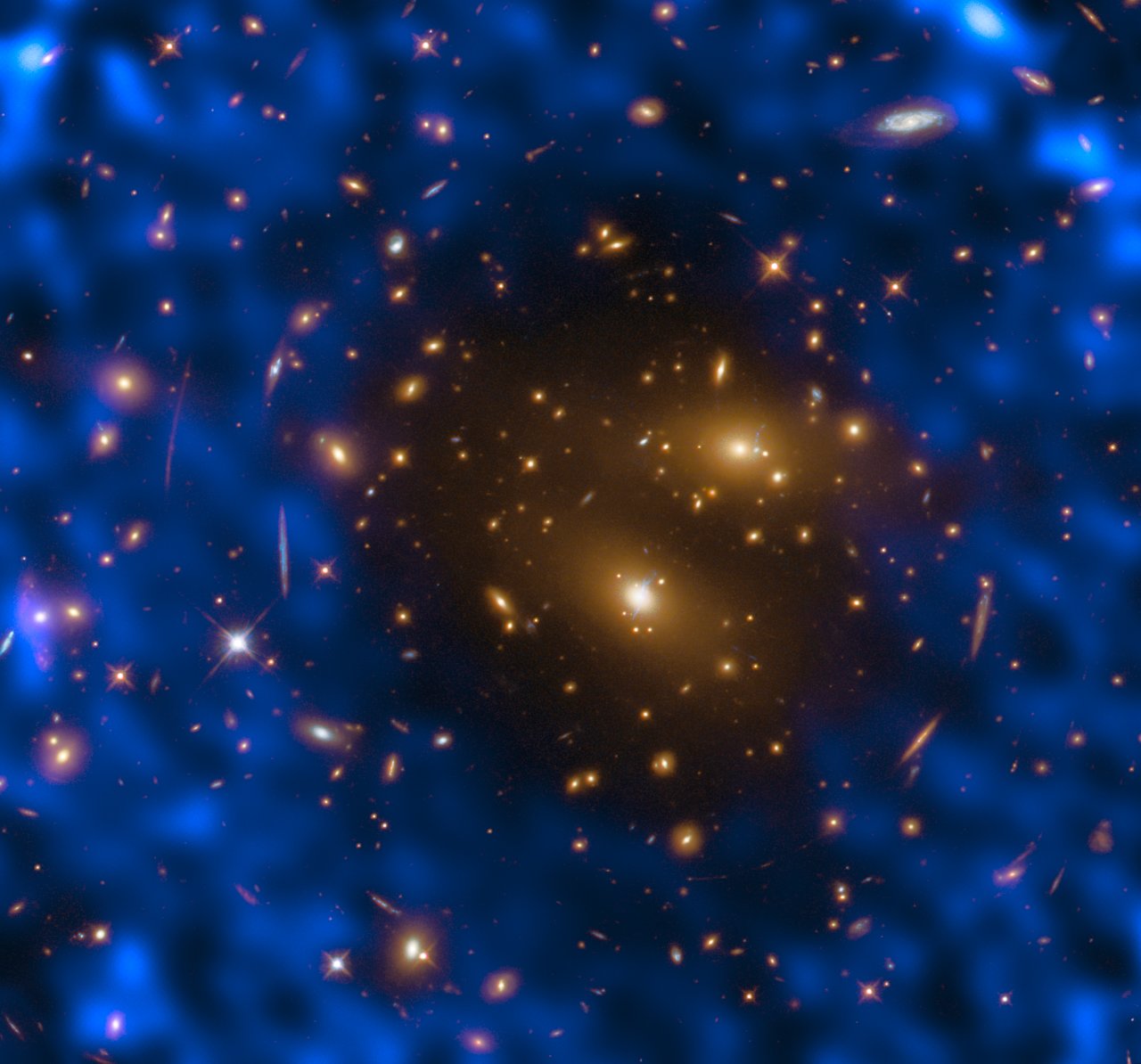Page 2 of 2
Re: Found images: 2017 February
Posted: Fri Feb 17, 2017 12:35 pm
by starsurfer
CG 1 and CG 2
http://www.tvdavisastropics.com/astroim ... 0000b8.htm
Copyright: Thomas Davis
CG 1 is the cometary globule near the centre and CG 2 is the smaller cometary globule below and to the left.
ESO/HEIC: ALMA’s Hole in the Universe / Astronomical Cooperation
Posted: Mon Feb 20, 2017 3:37 pm
by bystander
ALMA’s Hole in the Universe / Astronomical Cooperation
ESO / ESA Hubble Picture of the Week | 2017 Feb 20
The events surrounding the
Big Bang were so cataclysmic that they left an indelible imprint on the fabric of the cosmos. We can detect these scars today by observing the
oldest light in the Universe. As it was created nearly 14 billion years ago, this light — which exists now as weak
microwave radiation and is thus named the cosmic microwave background (
CMB) — has now expanded to permeate the entire cosmos, filling it with detectable
photons.
The CMB can be used to probe the cosmos via something known as the
Sunyaev-Zel’dovich (SZ) effect, which was first observed over 30 years ago. We detect the CMB here on Earth when its constituent microwave photons travel to us through space. On their journey to us, they can pass through
galaxy clusters that contain high-energy
electrons. These electrons give the photons a tiny boost of energy. Detecting these boosted photons through our telescopes is challenging but important — they can help astronomers to understand some of the fundamental properties of the Universe, such as the location and distribution of dense galaxy clusters.
This image shows the first measurements of the thermal Sunyaev-Zel’dovich effect from the Atacama Large Millimeter/submillimeter Array (
ALMA) in Chile (in blue). Astronomers combined data from ALMA’s 7- and 12-metre antennas to produce the sharpest possible image. The target was one of the most massive known galaxy clusters,
RX J1347.5–1145, the centre of which shows up here in the dark “hole” in the ALMA observations. The energy distribution of the CMB photons shifts and appears as a temperature decrease at the wavelength observed by ALMA, hence a dark patch is observed in this image at the location of the cluster.
The NASA/ESA Hubble Space Telescope observed one of most massive known galaxy clusters,
RX J1347.5–1145, seen in this Picture of the Week, as part of the Cluster Lensing And Supernova survey with Hubble (
CLASH). This observation of the cluster, 5 billion light-years from Earth, helped the Atacama Large Millimeter/submillimeter Array (
ALMA) in Chile to study the cosmic microwave background using the thermal Sunyaev-Zel’dovich effect. The observations made with ALMA are visible as the blue-purple hues.
Re: Found images: 2017 February
Posted: Sun Feb 26, 2017 1:00 pm
by starsurfer
Re: Found images: 2017 February
Posted: Sun Feb 26, 2017 1:18 pm
by starsurfer
IC 2087
http://www.atacama-photographic-observa ... .php?id=56
Copyright: Thierry Demange, Richard Galli and Thomas Petit
The dark nebula is B22.
Re: Found images: 2017 February
Posted: Sun Feb 26, 2017 1:24 pm
by starsurfer
Re: Found images: 2017 February
Posted: Sun Feb 26, 2017 1:28 pm
by starsurfer
California Nebula (NGC 1499)
http://www.straightontillmorning.me/Ast ... FSZRmGn/X2
Copyright: Hytham Abu-Safieh
Re: Found images: 2017 February
Posted: Sun Feb 26, 2017 1:31 pm
by starsurfer
Re: Found images: 2017 February
Posted: Sun Feb 26, 2017 1:36 pm
by starsurfer
M13
https://www.noao.edu/image_gallery/html/im1274.html
Copyright: T.A. Rector (University of Alaska Anchorage) and H. Schweiker (WIYN and NOAO/AURA/NSF)
Re: Found images: 2017 February
Posted: Sun Feb 26, 2017 1:38 pm
by starsurfer
Re: Found images: 2017 February
Posted: Sun Feb 26, 2017 1:40 pm
by starsurfer
Re: Found images: 2017 February
Posted: Sun Feb 26, 2017 1:43 pm
by starsurfer
Re: Found images: 2017 February
Posted: Mon Feb 27, 2017 3:36 pm
by canopia
Annular Solar Eclipse
https://www.facebook.com/stephen.beding ... 2761157563
Shot from the centreline near Facundo, Chubut, Argentina.
Copyright: Stephen Bedingfield

HEIC: A Remarkable Galactic Hybrid (UGC 12591)
Posted: Mon Feb 27, 2017 3:41 pm
by bystander
A Remarkable Galactic Hybrid
ESA Hubble Picture of the Week | 2017 Feb 27
This NASA/ESA Hubble Space Telescope image showcases the remarkable galaxy
UGC 12591. Classified as an
S0/Sa galaxy, UGC 12591 sits somewhere between a
lenticular and a
spiral. It lies just under 400 million light-years away from us in the westernmost region of the
Pisces–Perseus Supercluster, a long chain of galaxy clusters that stretches out for hundreds of light-years — one of the largest known structures in the cosmos.
The galaxy itself is also extraordinary: it is incredibly massive. The galaxy and its
halo together contain several hundred billion times the mass of the Sun; four times the mass of the Milky Way. It also whirls round extremely quickly, rotating at speeds of up to 1.8 million kilometres per hour!
Observations with Hubble are helping astronomers to understand the mass of UGC 12591, and to determine whether the galaxy simply formed and grew slowly over time, or whether it might have grown unusually massive by colliding and merging with another large galaxy at some point in its past.

